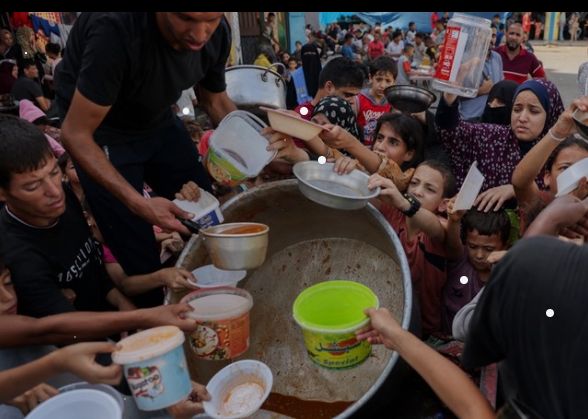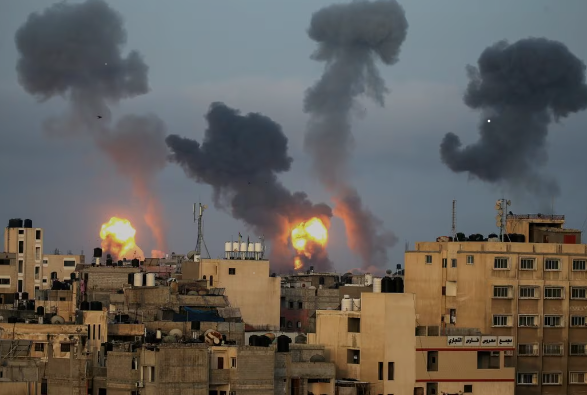“Hunger Deepens in Besieged Gaza”: Aid agencies report worsening conditions as the United Nations General Assembly plans to vote on an immediate humanitarian ceasefire in the ongoing two-month conflict between Israel and Hamas. Following the U.S. veto on Friday, Israel’s assault on Gaza continues, resulting in hundreds more civilian casualties. The densely populated coastal enclave has forced most of Gaza’s 2.3 million people from their homes, with residents struggling to find refuge or food. The U.N. World Food Programme has grimly stated that half of the population is now facing starvation.
“Hunger Grips Gaza”: The food crisis in the besieged Gaza Strip deepens, with Palestinians facing worsening conditions amid ongoing attacks. As the United Nations General Assembly prepares to vote on an immediate humanitarian ceasefire in the two-month conflict between Israel and Hamas, hundreds more civilians have lost their lives in Israel’s assault since the U.S. vetoed a Security Council resolution on Friday.

Driven from their homes, the majority of Gaza’s 2.3 million people find it impossible to seek refuge or food in the densely populated coastal enclave. The U.N. World Food Programme reports that half of the population is now starving.
UNRWA, the U.N. body responsible for Palestinian refugees, declares, “Hunger stalks everyone.” Gazans forced to flee repeatedly are not only facing the threats of hunger and cold but also the dangers of bombardments. Reports describe looting of aid trucks and soaring prices.
Israel argues that its instructions for people to move are protective measures as it seeks to root out Hamas militants responsible for an Oct. 7 cross-border attack. The retaliatory assault has resulted in 18,205 deaths and nearly 50,000 injuries, according to the Gaza health ministry.

The General Assembly is expected to pass a draft resolution on Tuesday, mirroring language from the Security Council resolution blocked by the United States last week. While General Assembly resolutions are not binding, they hold political weight and reflect global perspectives.
Some diplomats and observers anticipate that the upcoming vote will receive more significant support than the General Assembly’s October resolution, which called for “an immediate, durable, and sustained humanitarian truce.”
The vote was scheduled a day after 12 Security Council envoys visited the Egyptian side of the Rafah border crossing with Gaza, the sole location where limited humanitarian aid and fuel have entered. Notably, the United States did not dispatch a representative for the trip.

State Department spokesperson Matthew Miller informed reporters on Monday that Israel was not exempt from U.S. policy, asserting that any country receiving American weapons must adhere to the laws of war. This statement came after Washington sold approximately 14,000 tank shells to Israel without congressional review, using an emergency procedure.
“We are closely monitoring all developments in this conflict,” Miller stated. “We are in ongoing discussions with the Israeli government.”
As the intensity of the war has grown, scrutiny over how and where Israel employs U.S.-supplied weapons has increased. U.S. officials maintain that there are no plans to impose conditions on military aid to Israel or to consider withholding any part of it.

In response to images circulating on social media depicting Palestinian men detained in Gaza in their underwear, Miller expressed deep concern, stating that Washington had asked Israel to clarify the circumstances surrounding the photographs. Israel has contended that the men were stripped as a security measure to ensure they were not concealing explosives or weapons.
On Monday, the White House expressed concern about reports suggesting Israel’s use of U.S.-supplied white phosphorus munitions in an October attack in southern Lebanon and indicated a desire for more information. While these munitions can be legally employed on battlefields for purposes such as creating smoke screens, they also have the potential to cause severe burns.
Israel dismissed an allegation by Human Rights Watch that it uses white phosphorus munitions in Gaza and Lebanon as “unequivocally false.”

The vote was scheduled a day after 12 Security Council envoys visited the Egyptian side of the Rafah border crossing with Gaza, the only point where limited humanitarian aid and fuel have entered. Notably, the United States did not send a representative for the trip.
State Department spokesperson Matthew Miller informed reporters on Monday that Israel was not exempt from U.S. policy, emphasizing that any country receiving American weapons must adhere to the laws of war. This statement followed the sale of approximately 14,000 tank shells to Israel by Washington without congressional review, using an emergency procedure.
“We are closely monitoring all developments in this conflict,” Miller stated. “Ongoing discussions with the Israeli government are in progress.”

As the intensity of the war has escalated, scrutiny over how and where Israel deploys U.S.-supplied weapons has heightened. U.S. officials maintain that there are no plans to impose conditions on military aid to Israel or to consider withholding any part of it.
In response to images circulating on social media depicting Palestinian men detained in Gaza in their underwear, Miller expressed deep concern, stating that Washington had requested Israel to clarify the circumstances surrounding the photographs. Israel contends that the men were stripped as a security measure to ensure they were not concealing explosives or weapons.

On Monday, the White House voiced concern about reports suggesting Israel’s use of U.S.-supplied white phosphorus munitions in an October attack in southern Lebanon and expressed a desire for more information. While these munitions can be legally employed on battlefields for purposes such as creating smoke screens, they also have the potential to cause severe burns.
Israel rejected an allegation by Human Rights Watch that it uses white phosphorus munitions in Gaza and Lebanon as “unequivocally false.”
